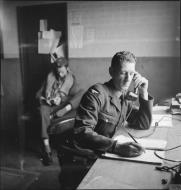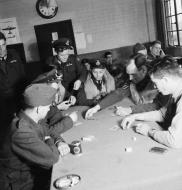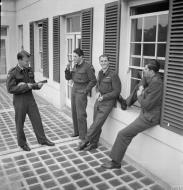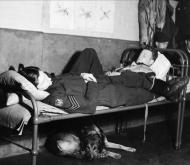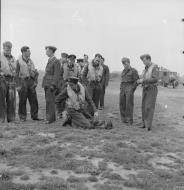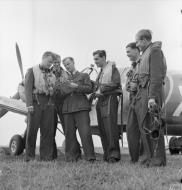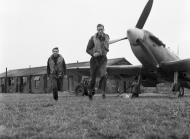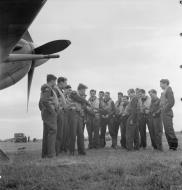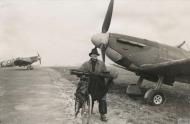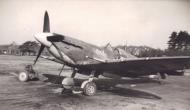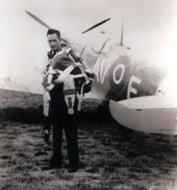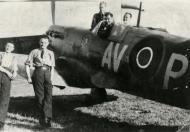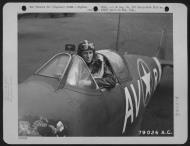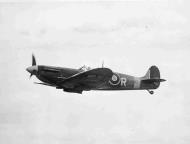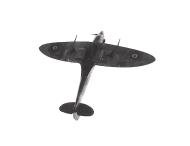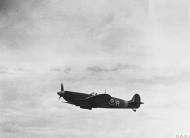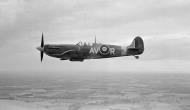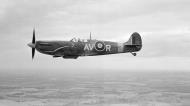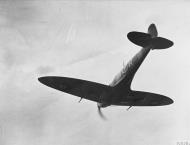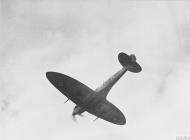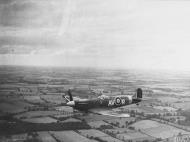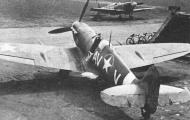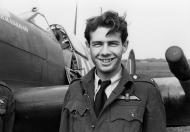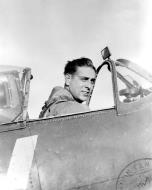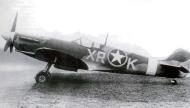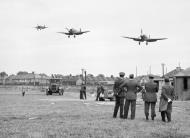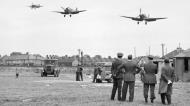Spitfire MkVb RAF 121Sqn AVR Olg BM590 based at Debden Essex IWM CH7337
Photo description: Supermarine Spitfire Mark VB, BM590 'AV-R' "Olga", of No. 121 Squadron RAF based at Debden, Essex, in flight.
Photo Source: Imperial War Museum IWM CH 7337 https://www.iwm.org.uk/collections/item/object/205208929
Aircrew RAF 121Sqn Nicholas Sintetos Cananda 1941
Spitfire MkVb RAF 121Sqn AVM Nicholas Sintetos AA880 July 1942
Photo description: Sgt. Nicholaos Sintetos during his training in Canada in 1941. The Greek-American pilot wanted to be a fighter pilot, although he was chosen for training in bombers. When he posted for service and Operational Training in England, Sintetos wrote a letter in the Air Ministry, where he stated that he already had an accident in Canada with multi-engine airplanes and that it would be better to transfer for training in fighters. Amazingly, his request fulfilled and after his fighter training, he was posted to No. 121 'Eagle' Squadron, manned by American citizens. (Greeksinforeigncockpits via www.56thfightegroup.com)
Photo description: No. 121 'Eagle' Sqn / No. 126 Sqn / 64th Fighter Squadron - 57th Fighter Group
Nicholas D. Sintetos was born in Ashtabula, Ohio on November 10, 1920. He was the son of a Greek Immigrants couple. His father, Dimitrios Sintetos was from a mountainous village in Arcadia District, Peloponnese named Vasta. He immigrated to the United States in 1906. His mother, Hellen Delligiannis was also from Arcadia, from a small village outside Tripoli named Agios Vasilios. She came to America in 1914 where he met Dimitrios, get married and had 4 children. Nicholas fell in love with aviation from his teenage years and he worked hard in order to get his first flying lessons in a Piper J-3 Cub, without having asked for money from his father. The outbreak of WW2, the dogfights over France and England as well as the Italy's attack on Greece on October 28, 1940, were enough reasons for him, in order to fill his papers and join to the United States Army Air Force. Although he already held a Private Pilots Licence he was not accepted in USAAF because it was required to have a two years college studies before being able to apply for a flying cadet. He was not discouraged and knowing that RAF needed as many pilots could get, he traveled in Canada and applied for RCAF. Attending the British Commonwealth Advanced Training Program (BCATP) he was qualified as a multi-engine aircraft pilot and later was sent to England to join one of the RAF light bomber operational training squadrons. However, he always wanted to be a fighter pilot and using cunning methods he managed to transfer to a fighter OTU. Completing his training and being an American citizen he was posted to the famous Eagle Squadrons, manned mainly by American pilots. He flew with No. 121 Squadron, flying numerous offensive missions over France, participating in dogfights where he was credited with a damaged Fw-190. Although he saw plenty of action while operating from England he applied for transfer in Malta because as he told in one of his interviews, he was trying to get rid of the deadly anti-aircraft fire! Malta was known as the fighter pilots paradise and he was sure that he would be able to participate in many dogfights. The Malta defenders were gaining the same publicity as their Battle of Britain fellow pilots. He was posted to the No.126 Squadron (also manned by many Americans), some days after the famous John Plagis left the island for England. He flew many sorties and had many adventures during his service in the sieged island and he was credited with one probable kill. Unfortunately his Squadron Leader, Flt/Lt. Bryan Wicks disliked him and his attitude almost cost the young Greek-American pilots life. Sintetos was a great wingman who was proud of not having lost a pilot who was flying with him. In September 1942 he was transferred from RAF to the USAAF and he joined the 64th Fighter Squadron of the 57th Fighter Group, flying the P-40 Warhawk over North Africa. He returned to the United States during 1943 where he was attached to the 1st Air Force, training pilots in Warhawks and later in Thunderbolts fighters. He was discharged in 1945 and he worked in the real estate as well as creating his own inventions and patents. He passed away on November 9, 1999, at 79 years old in San Bernardino California.
Aircrew RAF 121Sqn KM Osbourne with Sqn Ldr WB Williams IWM D9522
Photo description: Flying Officer K M Osbourne shares his experience of a 'dog fight' with his Commanding Officer, Squadron Leader W B Williams DFC and other members of the Eagle Squadron, following a fighter sweep. Left to right, they are: Flight Sergeant Bill Kelly, Flight Sergeant Sanders, Pilot Officer Don A Young, Flying Officer K M Osbourne, Squadron Leader W B Williams DFC, Pilot Officer Cadman Padget, three unidentified personnel, Pilot Officer F R Boyles, Flight Lieutenant Seldon R Edner (just visible), Flight Lieutenant Jim Daly DFC, Pilot Officer Jim Happel, and Flying Officer Barry Mahon.
Photo Source: Imperial War Museum IWM D 9522 https://www.iwm.org.uk/collections/item/object/205199503
Aircrew RAF 121Sqn at RAF Rochford in Essex Aug 1942 IWM D9521
Photo description: American volunteer pilots of No.121 (Eagle) Squadron run to their aircraft at RAF Rochford in Essex, August 1942. Flying Officer Barry Mahon (left) and Flight Lieutenant Seldon R Edner run to their aircraft as they are given the order to scramble. Both men are from California. The original caption states that enemy aircraft had appeared at 25,000 feet, seven miles south of the station, hence the need for action.
Photo Source: Imperial War Museum IWM D 9521 https://www.iwm.org.uk/collections/item/object/205199502
Aircrew RAF 121Sqn at RAF Rochford in Essex Aug 1942 IWM D9520
Photo description: American volunteer pilots of No.121 (Eagle) Squadron run to their aircraft at RAF Rochford in Essex, August 1942. Flying Officer Barry Mahon (left) and Flight Lieutenant Seldon R Edner run to their aircraft as they are given the order to scramble. Both men are from California. The original caption states that enemy aircraft had appeared at 25,000 feet, seven miles south of the station, hence the need for action.
Photo Source: Imperial War Museum IWM D 9520 https://www.iwm.org.uk/collections/item/object/205199501
Aircrew RAF 121Sqn at RAF Rochford in Essex Aug 1942 IWM D9519
Photo description: Men of No 121 (Eagle) Squadron stand and wait for their call to action on the grass at Rochford airfield. Left to right they are: Flying Officer K M Osbourne, Squadron Leader W B Williams DFC (the Commanding Officer), an unidentified English officer of the ground staff, Pilot Officer Don A Young, Pilot Officer Frank R Boyles, an unidentified squadron member, Flight Lieutenant Seldon R Edner, Flight Sergeant Jim Sanders, an unidentified squadron member, Pilot Officer Jim Happel and another unidentified squadron member, possibly Flight Officer Hasey. In the foreground, Pilot Officer Cadman Padget plays with the squadron mascot, a dog named Roger.
Photo Source: Imperial War Museum IWM D 9519 https://www.iwm.org.uk/collections/item/object/205199500
Aircrew RAF 121Sqn at RAF Rochford in Essex Aug 1942 IWM D9518
Photo description: American volunteers, Flight Sergeant Bill Kelly (left) and Flying Officer Osbourne of No. 121 (Eagle) Squadron, RAF, at rest in the Dispersal Hut at Rochford airfield in Essex during 1942.Flight Sergeant Bill Kelly (left) and Flying Officer Osbourne sleep between 'sweeps' in the Dispersal Hut at Rochford airfield. Underneath the bed on which they sleep is the station mascot, a dog called Roger. The original caption states that "Like so many of the fighter squadron mascots, Roger belonged to a pilot since reported missing, and has been adopted by the others".
Photo Source: Imperial War Museum IWM D 9518 https://www.iwm.org.uk/collections/item/object/205199499
Aircrew RAF 121Sqn at RAF Rochford in Essex Aug 1942 IWM D9517
Photo description: Flying Officer Osbourne plays a tune on his banjulele as entertainment for his Eagle Squadron colleagues on the terrace of the old English house in which they are billeted. Left to right, the 'audience' is: Pilot Officer Kearney (smoking a pipe), Pilot Officer Slater and Pilot Officer Padget (seated on the window sill).
Photo Source: Imperial War Museum IWM D 9517 https://www.iwm.org.uk/collections/item/object/205199498
Aircrew RAF 121Sqn at RAF Rochford in Essex Aug 1942 IWM D9514
Photo description: Flying Officer Osbourne plays a tune on his banjulele as entertainment for his Eagle Squadron colleagues on the terrace of the old English house in which they are billeted. Left to right, the 'audience' is: Pilot Officer Kearney (smoking a pipe), Pilot Officer Slater and Pilot Officer Padget (seated on the window sill).
Photo Source: Imperial War Museum IWM D 9514 https://www.iwm.org.uk/collections/item/object/205199497
Aircrew RAF 121Sqn at RAF Rochford in Essex Aug 1942 IWM D9513
Photo description: In the Dispersal Hut at Rochford airfield, the telephonist logs a call from the Control Tower, confirming that 12 Spitfires are successfully airborne. In the background, a 'spare' pilot reads a book.
Photo Source: Imperial War Museum IWM D 9513 https://www.iwm.org.uk/collections/item/object/205199496
Spitfire MkVbs RAF 121Sqn landing at RAF Rochford in Essex Aug 1942 IWM D9509
Photo description: Personnel of No 121 (Eagle) Squadron look on as three Spitfire Vbs come in to land after a fighter sweep over northern France. Some of the accommodation used by the Squadron is visible in the background, as are several civilian houses. Also visible are two Royal Air Force vehicles.Personnel of No.121 (Eagle) Squadron look on as three Spitfire Vbs come in to land at RAF Rochford in Essex, after a fighter sweep over northern France during August 1942.
Photo Source: Imperial War Museum IWM D 9509 https://www.iwm.org.uk/collections/item/object/205199495
Spitfire MkVb RAF 121Sqn AVR BM590 Capt Don Willis stands beside his aircraft England July 1942 NA1877
Spitfire MkVb RAF 121Sqn AVR BM590 Capt Don Willis in his aircraft England July 1942 NA1859
Photo description: Few flying men have as much to forget—or remember—as Capt. Donald Willis of Marion, Ind. At the beginning of the war he joined the Finnish Air Force and has since flown with the RAF, Norway and the USAF 2nd Eagle Squadron. Here he leans on the prop of his favorite fighter, a British "Spitfire", at the 4th Fighter Group base at Lincolnshire, England. 14 November 1943. CAPT Don Willis as Operations Officer for the 335th Ftr Sq, 4th FG. The "14 November 1943" date on the photo caption is erroneous on two counts: Willis transferred to HQ 8FC in April of that year, and by November the Group had (regrettably) transitioned to P-47s. (U.S. Air Force Number 80554AC) and (U.S. Air Force Number 79026AC)
Photo Source: National Archives Identifier NA1877 NAID: 204878878 Local ID: 342-FH-3A12436-80554AC
Photo Source: National Archives Identifier NA1859 NAID: 204878850 Local ID: 342-FH-3A12426-79026AC
 Editor for Asisbiz: Matthew Laird Acred
Editor for Asisbiz: Matthew Laird Acred
